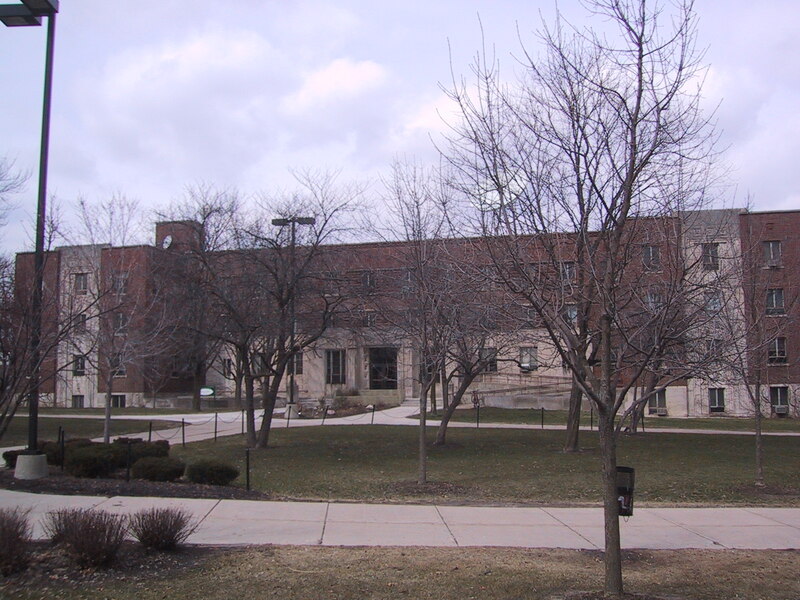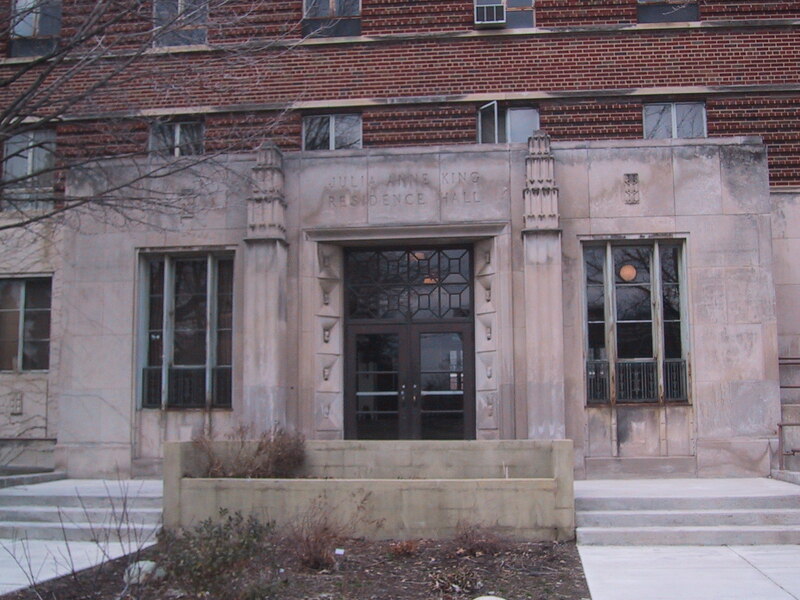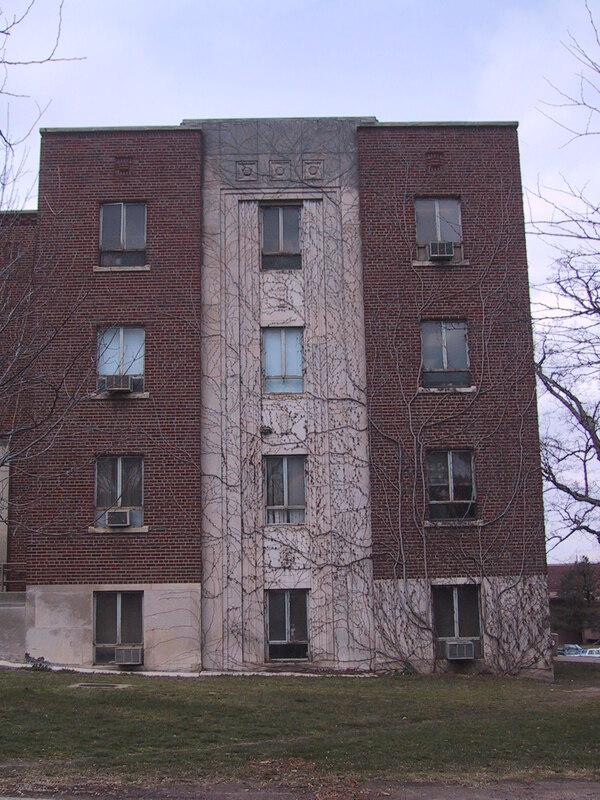-
Building Name
-
King Hall
-
Description
-
King Hall and its companion building Goodison (now demolished), constructed in 1939, were among the first dormitories built on Eastern Michigan's campus. Photographs of the work in process show that they were built with Public Works Association (PWA) labor. The PWA had been established as a method to bring the unemployed back to work during the Great Depression. These architects and laborers were instrumental in developing the brick and pale stone style popular on the southern side of the campus.
These two dormitories, constructed as women's housing were designed in the shape of two opposing Us enclosing a private courtyard for recreation. In the ground-breaking floor plans, architects created the first two-room dormitory suites in the state. Each suite included a bedroom with an adjoining study. Furnishings included a twin-sized maple bed for each student with mattress, box spring, and pillow; a built in dresser and closet; a bedside rug; and dressing table. The study room contained a double desk with a shelf for a typewriter or books, a bookcase, study chair, and easy chair. Halls shared bathrooms that included an electric hairdryer. Other conveniences included five date parlors, and a laundry room with tubs, ironing boards and clothes dryers. The complex included a cafeteria and dining room for meals. Lunch was served cafeteria style but dinner was a more elaborate affair with assigned tables and a student hostess to oversee the meal. The school attempted to create a sense of gentility in their dormitories. For all these amenities, room and board cost $144 per semester, payable in two installments of $72.00 each.
King Hall was renovated in 1971, and converted from a dormitory to a multipurpose building with classrooms, offices, and practice rooms (as it was originally renovated to house the Music Department). Today, King serves as the home of our award-winning NPR radio station, WEMU, and the campus newspaper the Eastern Echo.
-
Namesake Biography
-
King Hall was named for Julia Anne King, former Preceptress, or Dean of Women at State Normal (1881-1886) and first Head of the Department of History and Social Science (1886-1914). King was known for her interest in the development of students at Normal. Every Friday afternoon, she gave Conversations with female students in which she discussed practical questions like dress, manners, and religion. Later these conversations shifted in character to the manner of sermons reminding her listeners of how proper ladies should behave. Colleges felt a moral imperative to teach their students not only information but also how to live better, more moral lives. Hirman King and his wife Charlotte Jones King left Vermont around 1830 and settled in Milan, Monroe County, Michigan, where they cleared a place in the forest and together built a log house and began farming. Eight children were born to this pioneer family; one boy and two girls died in infancy; four girls and one boy grew to adulthood. The fourth girl, Julia Ann, was born September 28, 1838. King attended the Milan district schools until the age of fourteen when she entered Adrian high school, and three years later she came to the Michigan State Normal School in Ypsilanti where she graduated in 1858. She began teaching in the St. Clair schools aiding in establishment of a high school department, of which she had charge. After leaving St. Clair and taking a postgraduate year at the Normal School, she became the principal of Lansing high school, and from there became the principal of the ladies department of Kalamazoo College. It was from this institution that she later received her master of arts. After three years in this college she became preceptress and teacher of literature, modern language and history in the Flint high school, remaining there for nine years. She then became the principal in Charlotte, and after one year, superintendent of schools, where her work for the next five years attracted much attention. In 1881, she became preceptress of the Michigan State Normal School, and retained this position until it was abolished under Principal Boone. She was also the head of the History Department until her retirement in 1914, when she was made professor emeritus by the state board of education and for two years after gave lectures in the College on her favorite subjects. King was one of the first teachers in the west to adopt the modern method of studying history and her work drew to this college much favorable notice. She was also a woman of unusual force of character and impressed her personality upon all who came under her direction. Since her retirement, she has lived in Ypsilanti or at her cottage near Port Huron on Lake Huron. King died Monday May 5, 1919.
-
Building Namesake
-
Julia Anne King, Dean of Women, 1881-1886, Head of History and Social Science Department, 1886-1913
-
Year Constructed
-
1939
-
Building Functions
-
WEMU; Administrative Offices
-
Architect
-
R.S. Gerganoff, Ypsilanti, MI
-
Builder
-
Henry C. Weber Construction Comapny
-
Original Cost
-
707752
-
Architectural Style
-
WPA Moderne
-
Square Footage
-
65,706
-
Rights
-
This Item is protected by copyright and/or related rights. You are free to use this Item in any way that is permitted by the copyright and related rights legislation that applies to your use. In addition, no permission is required from the rights-holder(s) for educational uses. For other uses, you need to obtain permission from the owner, Eastern Michigan University Archives (lib_archives@emich.edu).






